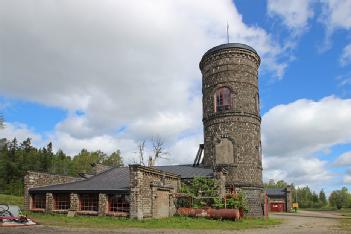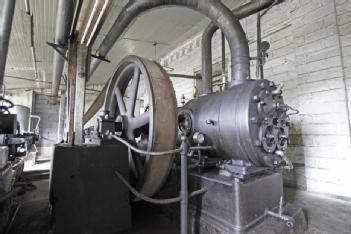
Klackbergs gruvfält |
73891 Norberg, Sweden (Värmlands län) |
|
| Address |
Flängavägen 3
|
| Floor area | unfortunately not known yet |
|
Opening times
|
Visit the surroundings on your own. Well signposted.
Besök omgivningen på egen hand. Väl skyltat.
|
||||
|
Status from 12/2019
|
Free entry. | ||||
| Contact |
|
||||
| Homepage | ekomuseum.se/besoksmalen/klackbergs-gruvfalt | ||||
| Location / Directions |
Klackberg is a now abandoned iron ore mine field in Norberg's parish, Norberg municipality. The field is located on the western shore of Lake Noren. The Klackberg area is signposted with information boards and directions. |
|||
| Location / Directions (other) |
Klackberg är ett numera övergivet järnmalmsgruvfält i Norbergs socken, Norbergs kommun. Fältet ligger vid västra stranden av sjön Noren.
Klackbergsområdet är skyltat med informationstavlor och vägvisning |
|||
| Description | The oldest parts of the mine are the "Springegruvan" and "Solskensbergsgruvan". In the "Blue Cave" you can see how the tunnel was driven through the rock by fire. This method is called "curing". By burning wood next to the mountain slopes, the rock becomes brittle and easily fragile. This makes the mountain slopes smooth and softly rounded. The industrial installations found in the area date from 1880-1920, and the two round winding towers with ornamentation and arched windows are unique in their kind. Both towers are located above the excavation shafts, which are several hundred metres deep. Lifts and machinery are also partly preserved in the buildings and can be demonstrated. Wikipedia: Mining field The Klackberg mining area is already mentioned in 1303 as a "steel mountain". Among the mines are mainly Gröndalsgruvan and Storgruvan. A manganese-lime-black ore with 50% iron, 0.004% phosphorus and generally less than 0.1% sulphur was mined. The remaining industrial plants in the area date from the period 1880-1920. Nature reserve |
| Description (other) |
De äldsta delarna av gruvfältet är Springegruvan och Solskensbergsgruvan. I Blå grottan kan man se hur stollgången drivits genom berget med hjälp av eld. Metoden kallas tillmakning och går till så att man eldar med ved intill bergssidorna varvid berget blir sprött och lättbrutet. Bergssidorna blir släta och mjukt rundade vid tillmakningen. Vi sprängning däremot trasas berget sönder och man kan se rester av borrhål i vilka krutet eller dynamiten lades. Exempel på detta kan man se i den tunnel som utgår från Storgruvan och genom vilken malmen transporterades ut till järnvägen. De industrianläggningar som man finner här i området är från perioden 1880-1920. Helt unika i sitt slag är de båda runda gruvlavarna av slaggtegel med utsmyckningar och valvbågade fönster. Båda lavtornen är placerade över uppfordringsschakt som är flera hundra meter djupa. Även hissar, spel och maskinutrustning är delvis bevarade i byggnaderna och kan demonstrationsköras. Wikipedia: Gruvfältet Klackbergs gruvfält omtalas redan år 1303 som ”Stål berget”. Främst bland gruvorna märks Gröndalsgruvan och Storgruvan. De äldsta delarna av gruvfältet är Springegruvan och Solskensbergsgruvan. Malmen som bröts var en manganhaltig, kalkig svartmalm med 50% järn, 0,004 % fosfor och i allmänhet under 0,1 % svavel. De industrianläggningar som är kvar i området är från perioden 1880-1920. Naturreservatet Idag utgör Klackberget ett friluftområde med vandringsleder. Här finns även Klackbergs naturreservat, som är kommunalt och cirka 800 m långt. Det omfattar dagbrottsområdet och ett kalkbrott. Huvudentré är vid Norbergs skidstadion. I reservatet finns Storgruvans och Gröndalsgruvans lavar kvar. Från uttransporten av malm finns en tunnel från 1899. Kalk bröts för att tillsättas i masugnarna och en kalkugn är bevarad. Kalkförekomsten har gynnat vissa växtarter. Orkidén rödsyssla har här sin nordligaste växtplats i Sverige och hasseln sin nordvästgräns. Några fågelarter man kan se är rödvingetrast, grönsångare och rödhake. |
[dsp_museum_detail.cfm]
| Data Compliance | More Information |

